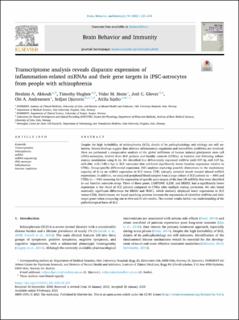| dc.contributor.author | Akkouh, Ibrahim | |
| dc.contributor.author | Hughes, Timothy | |
| dc.contributor.author | Steen, Vidar Martin | |
| dc.contributor.author | Glover, Joel | |
| dc.contributor.author | Andreassen, Ole Andreas | |
| dc.contributor.author | Djurovic, Srdjan | |
| dc.contributor.author | Szabo, Attila | |
| dc.date.accessioned | 2021-08-11T07:16:41Z | |
| dc.date.available | 2021-08-11T07:16:41Z | |
| dc.date.created | 2021-02-24T13:02:59Z | |
| dc.date.issued | 2021 | |
| dc.identifier.issn | 0889-1591 | |
| dc.identifier.uri | https://hdl.handle.net/11250/2767273 | |
| dc.description.abstract | Despite the high heritability of schizophrenia (SCZ), details of its pathophysiology and etiology are still unknown. Recent findings suggest that aberrant inflammatory regulation and microRNAs (miRNAs) are involved. Here we performed a comparative analysis of the global miRNome of human induced pluripotent stem cell (iPSC)-astrocytes, derived from SCZ patients and healthy controls (CTRLs), at baseline and following inflammatory modulation using IL-1β. We identified four differentially expressed miRNAs (miR-337-3p, miR-127-5p, miR-206, miR-1185-1-3p) in SCZ astrocytes that exhibited significantly lower baseline expression relative to CTRLs. Group-specific differential expression (DE) analyses exploring possible distinctions in the modulatory capacity of IL-1β on miRNA expression in SCZ versus CTRL astroglia revealed trends toward altered miRNA expressions. In addition, we analyzed peripheral blood samples from a large cohort of SCZ patients (n = 484) and CTRLs (n = 496) screening for the expression of specific gene targets of the four DE miRNAs that were identified in our baseline astrocyte setup. Three of these genes, LAMTOR4, IL23R, and ERBB3, had a significantly lower expression in the blood of SCZ patients compared to CTRLs after multiple testing correction. We also found nominally significant differences for ERBB2 and IRAK1, which similarly displayed lower expressions in SCZ versus CTRL. Furthermore, we found matching patterns between the expressions of identified miRNAs and their target genes when comparing our in vitro and in vivo results. The current results further our understanding of the pathobiological basis of SCZ. | en_US |
| dc.language.iso | eng | en_US |
| dc.publisher | Elsevier | en_US |
| dc.rights | Navngivelse 4.0 Internasjonal | * |
| dc.rights.uri | http://creativecommons.org/licenses/by/4.0/deed.no | * |
| dc.title | Transcriptome analysis reveals disparate expression of inflammation-related miRNAs and their gene targets in iPSC-astrocytes from people with schizophrenia | en_US |
| dc.type | Journal article | en_US |
| dc.type | Peer reviewed | en_US |
| dc.description.version | publishedVersion | en_US |
| dc.rights.holder | Copyright 2021 The Author(s). | en_US |
| cristin.ispublished | true | |
| cristin.fulltext | original | |
| cristin.qualitycode | 2 | |
| dc.identifier.doi | 10.1016/j.bbi.2021.01.037 | |
| dc.identifier.cristin | 1893192 | |
| dc.source.journal | Brain, Behavior, and Immunity | en_US |
| dc.source.pagenumber | 235-244 | en_US |
| dc.identifier.citation | Brain, Behavior, and Immunity. 2021, 94, 235-244. | en_US |
| dc.source.volume | 94 | en_US |

